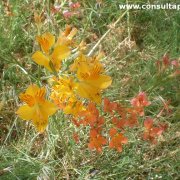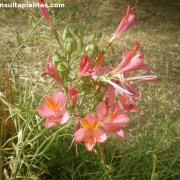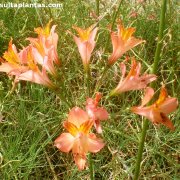Care of the rhizomatous plant Alstroemeria revoluta or Inca Lily |
|
The genus Alstroemeria, family Alstroemeriaceae, includes more than 100 species of rhizomatous plants originating from the Andes, in South America. Some species are: Alstroemeria revoluta, Alstroemeria aurea, Alstroemeria ligtu, Alstroemeria haemantha, Alstroemeria psittacina, Alstroemeria caryophyllaea, Alstroemeria patagonica, Alstroemeria pulchella. Common name: Inca Lily. This species is native to Chile and Peru. They are perennial rhizomatous plants that reach 80 cm (2.62 feet) in height. They have linear ribbed light green leaves. The attractive 6-petaled flowers can be red, pink, yellow, or orange. They bloom in summer. Inca Lily is used on dry slopes, on edges, in flowerbeds and as cut flowers. Alstroemeria revoluta grows in full sun and partial shade exposures. It resists light frosts up to -5 ºC (41 ºF). The soil can be normal garden soil that is well drained and contains some organic matter. Water regularly waiting for the substrate to dry completely. They resist several days of drought. Fertilize with a little compost at the time of planting. Prune faded flowers at the end of the blooming period. Alstroemeria revoluta is a plant resistant to the usual pests and diseases but sensitive to the accumulation of water in the roots. Inca Lily is propagated from seeds sown in the fall in the nursery; keep the seeds in water for 24 hours before sowing. |
Images of the rhizomatous plant Alstroemeria revoluta or Inca Lily |
Find plants
Alstroemeria revoluta or Inca Lily | Care and Growing
© 2025 FavThemes


